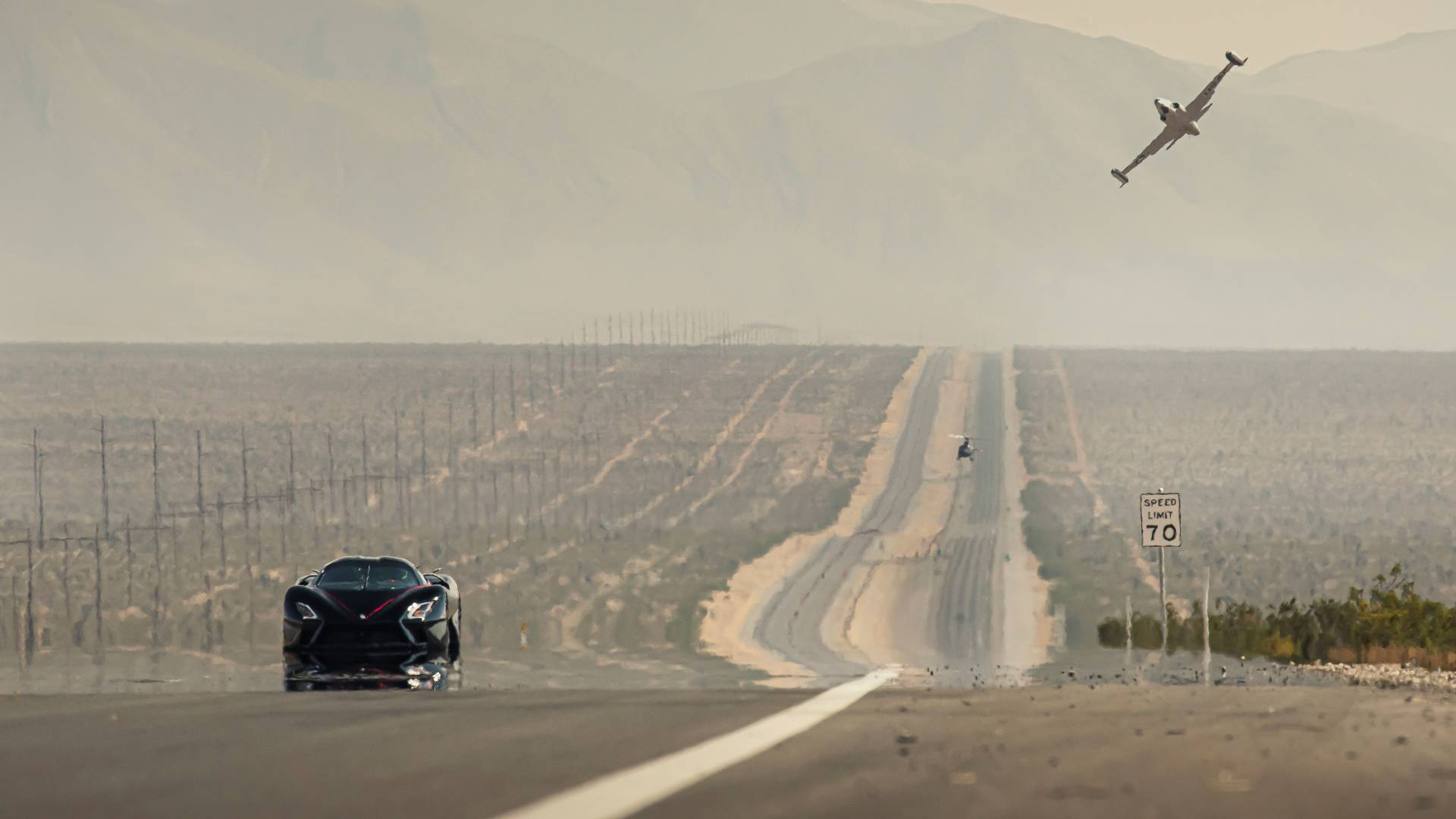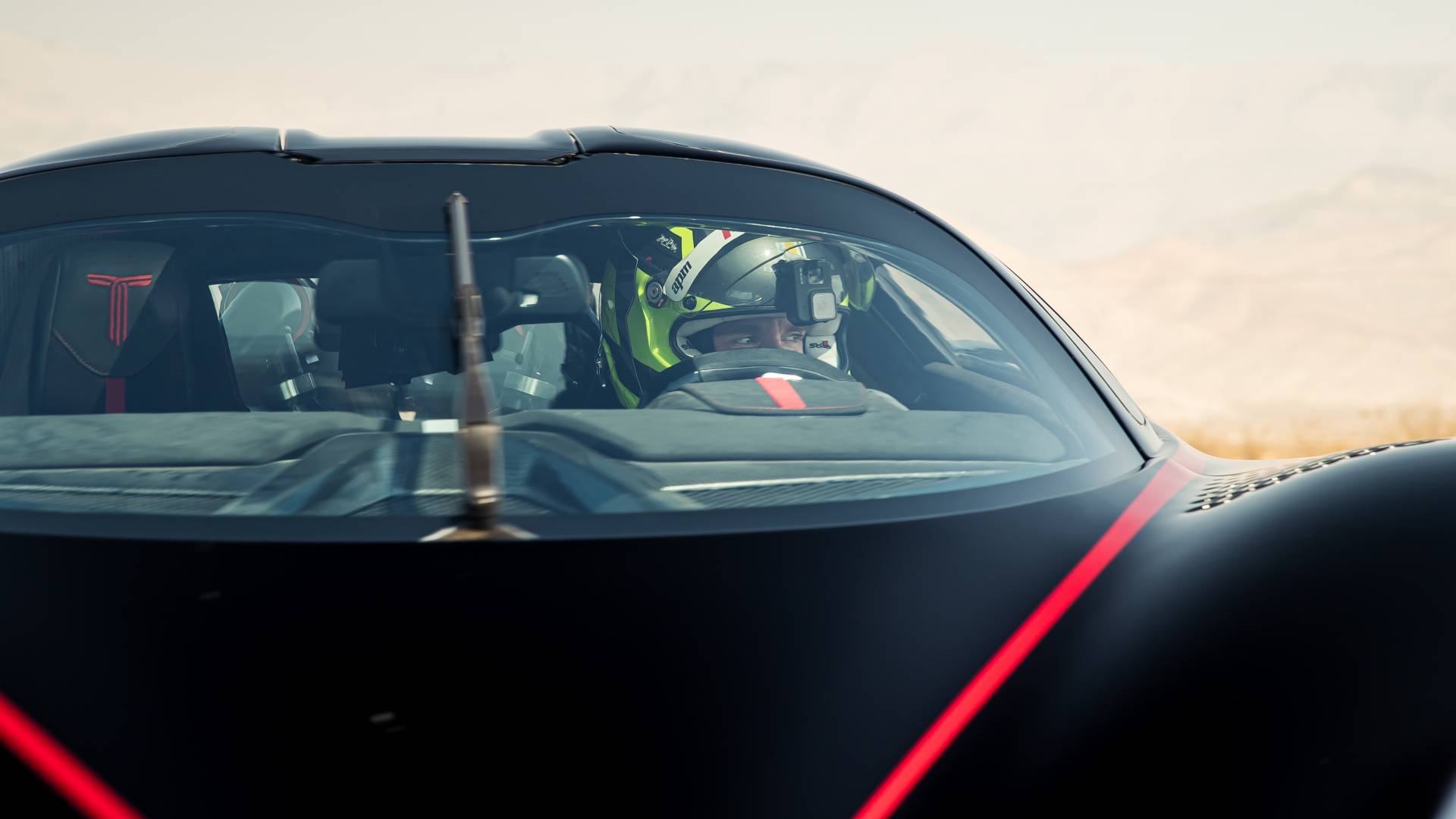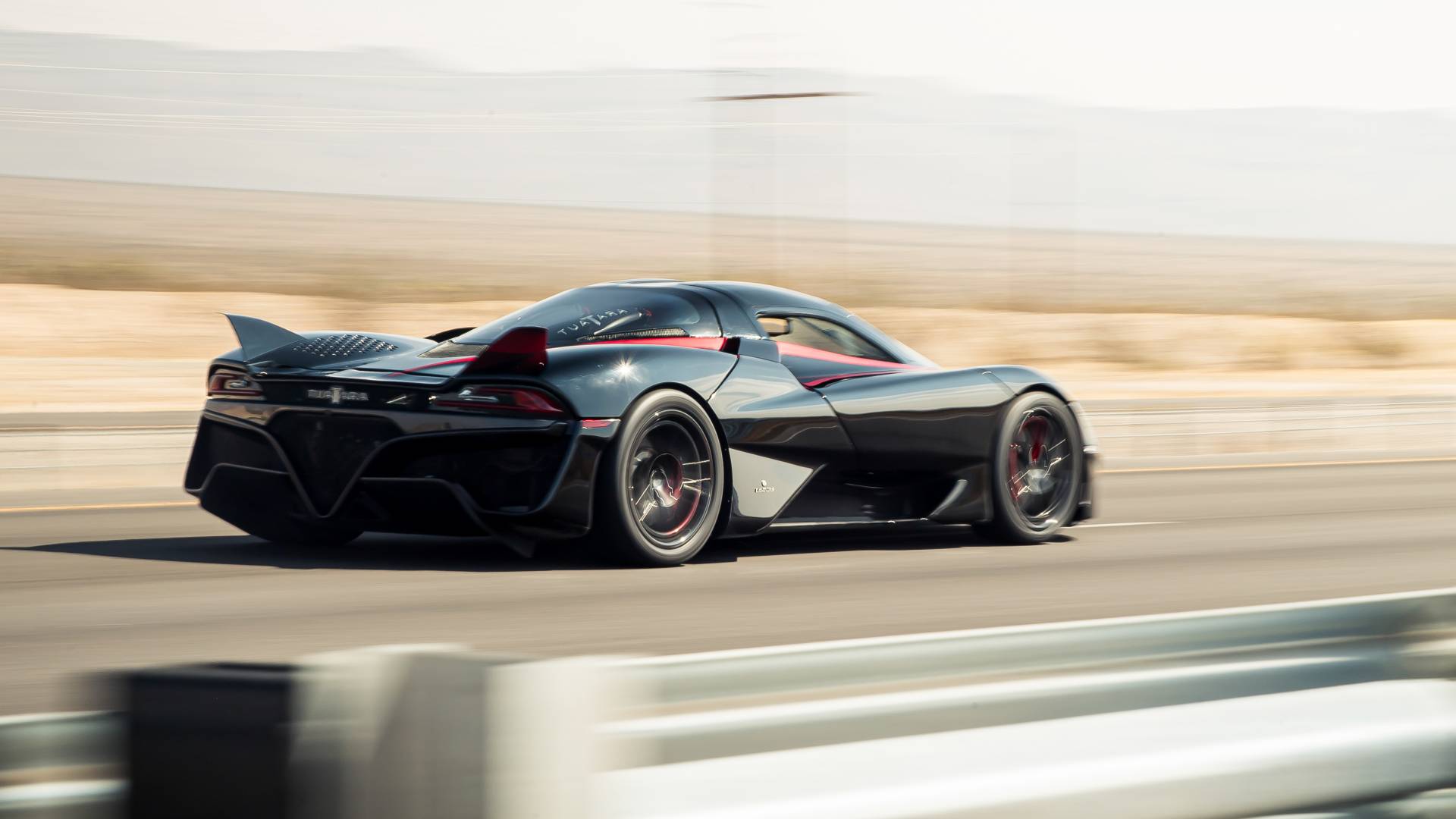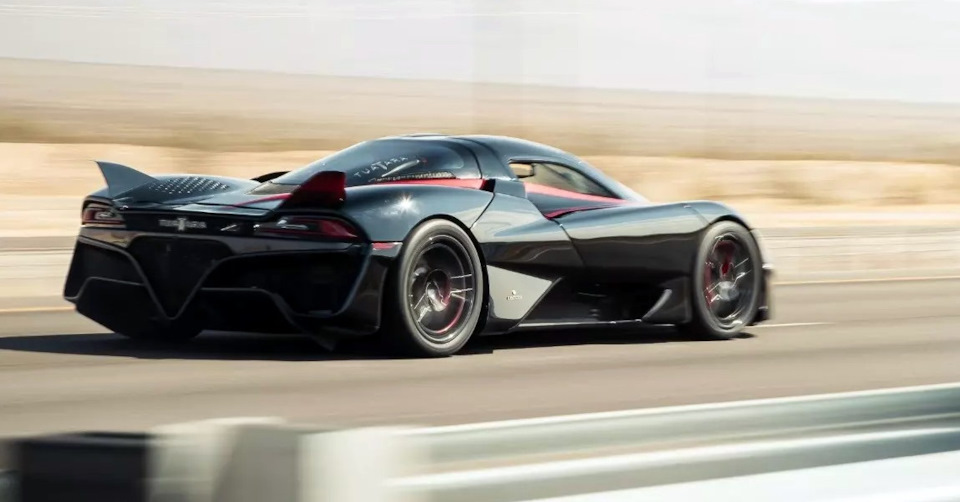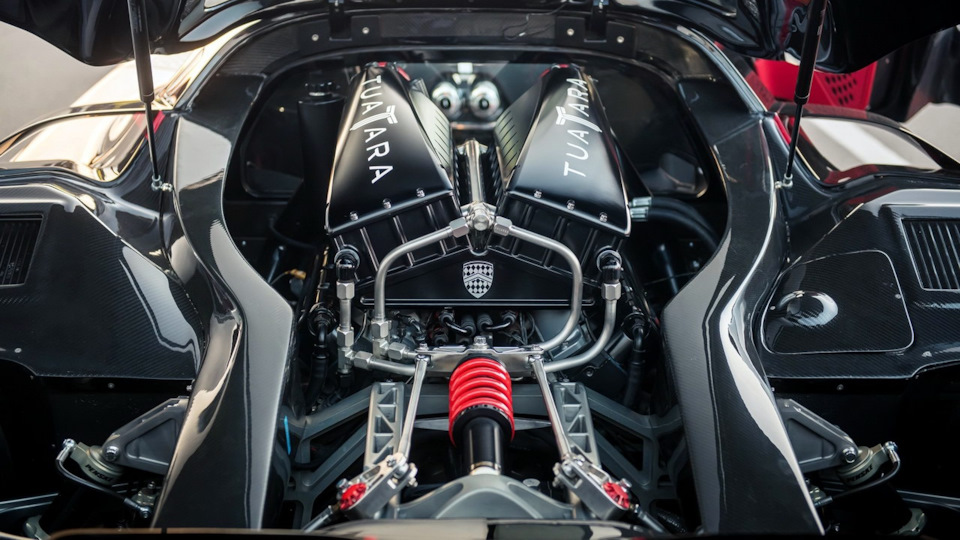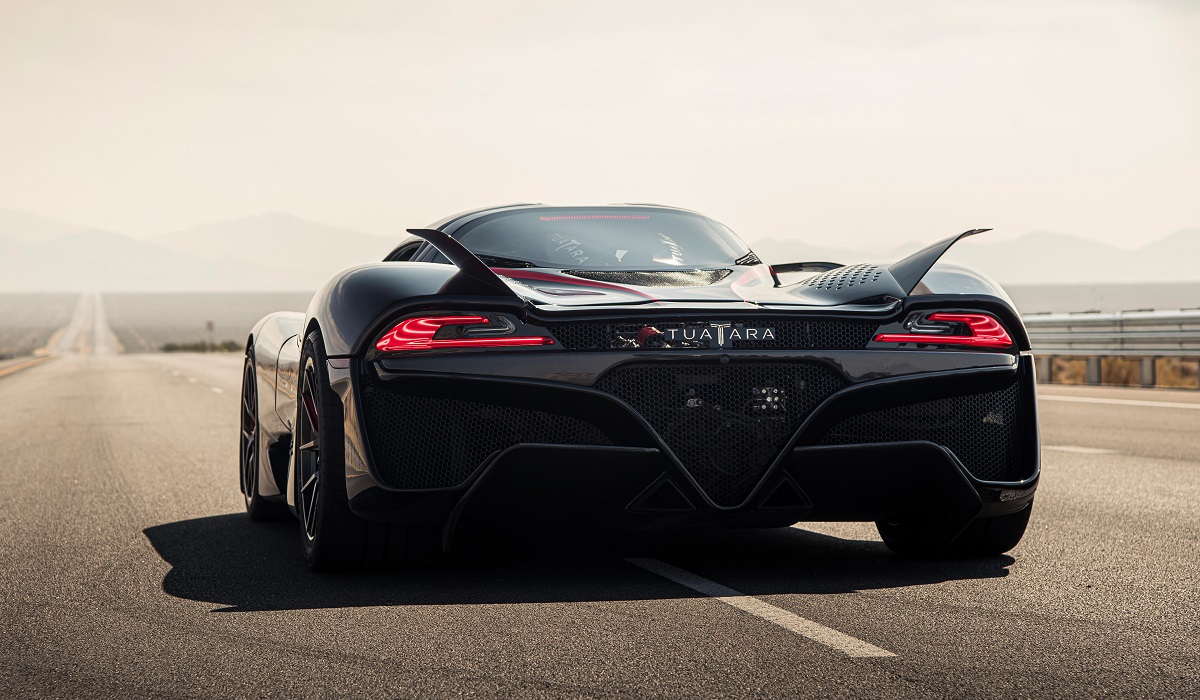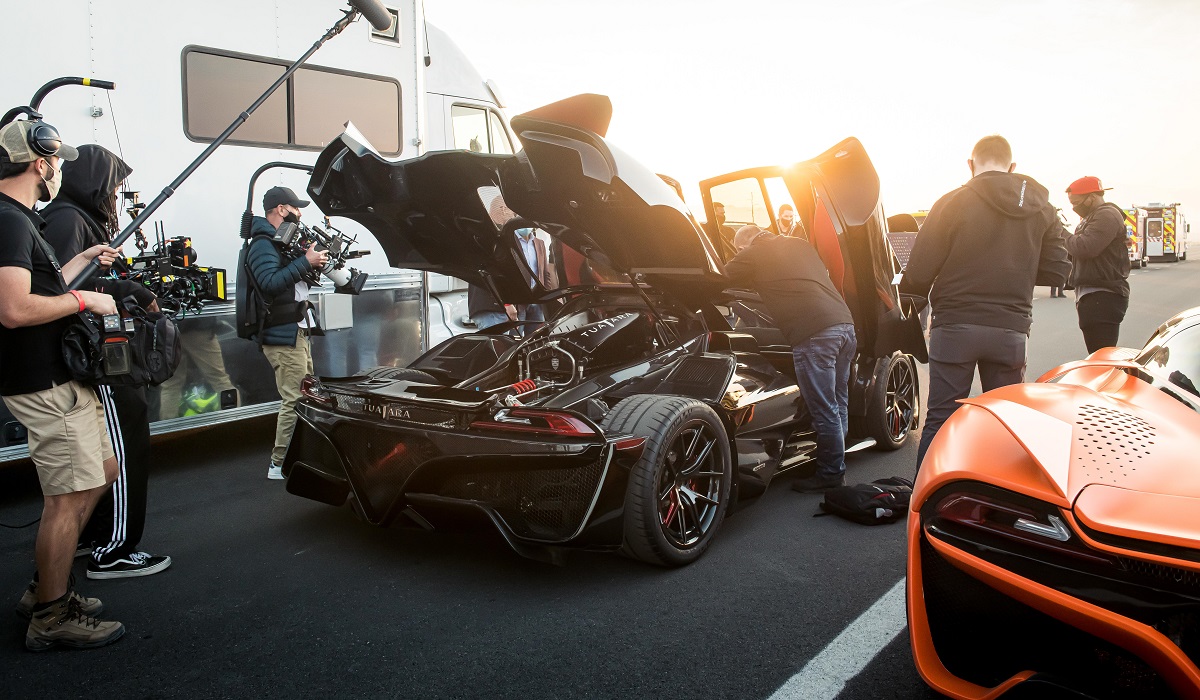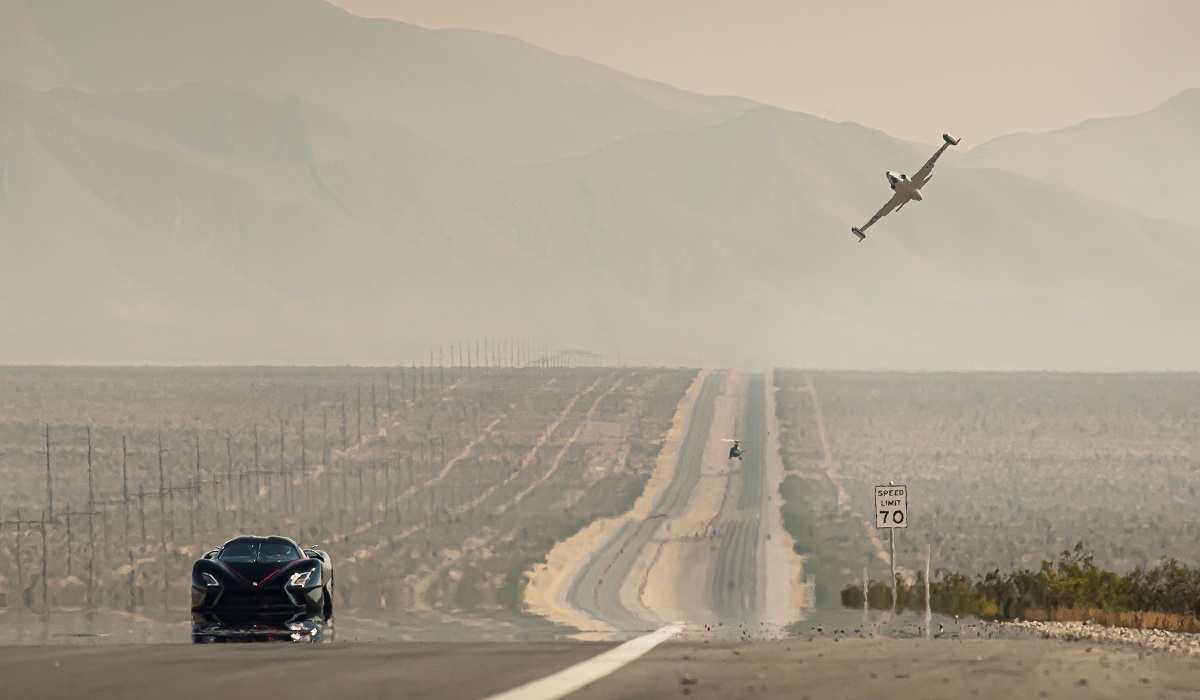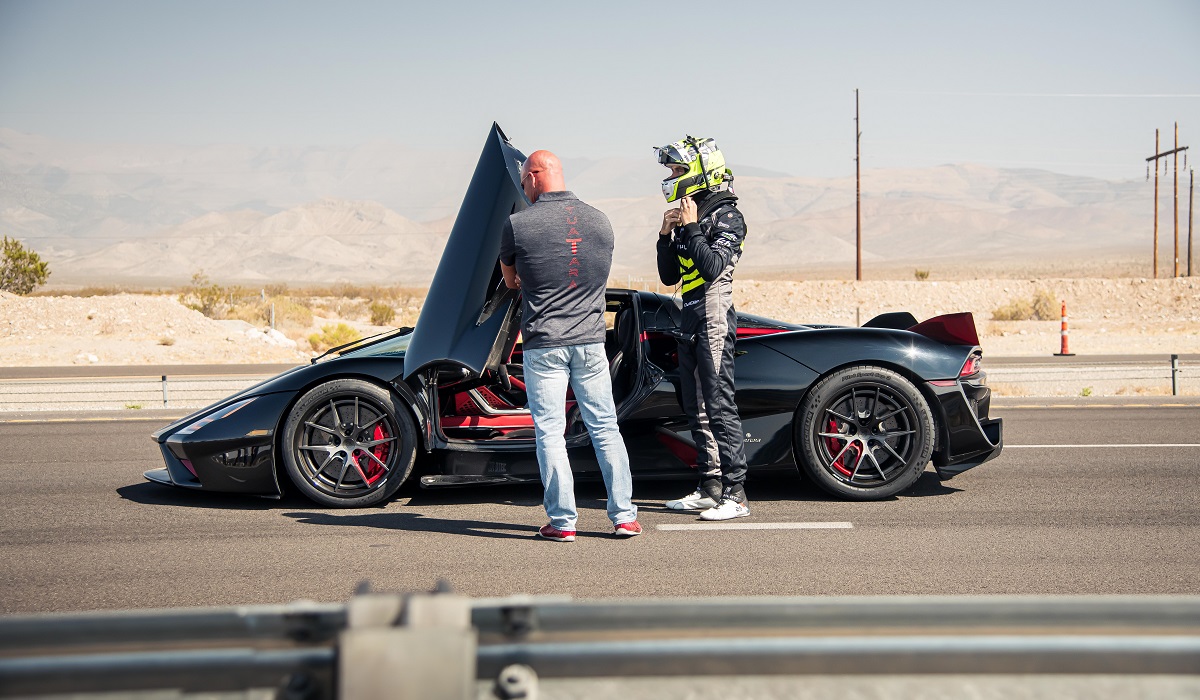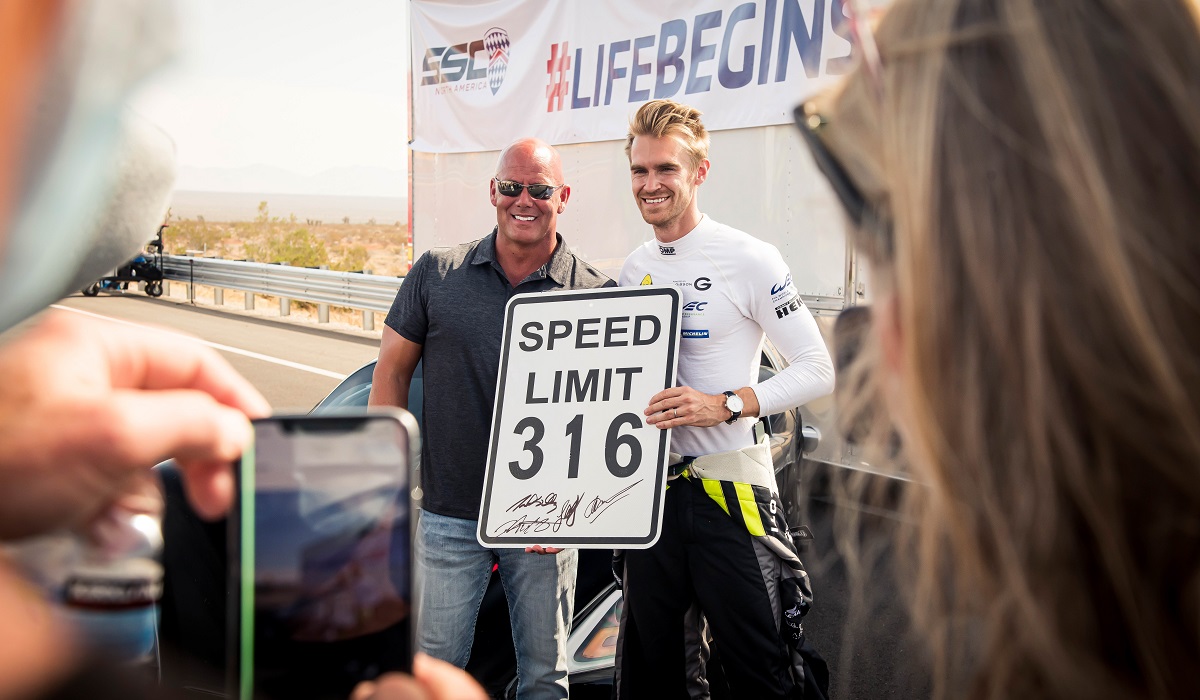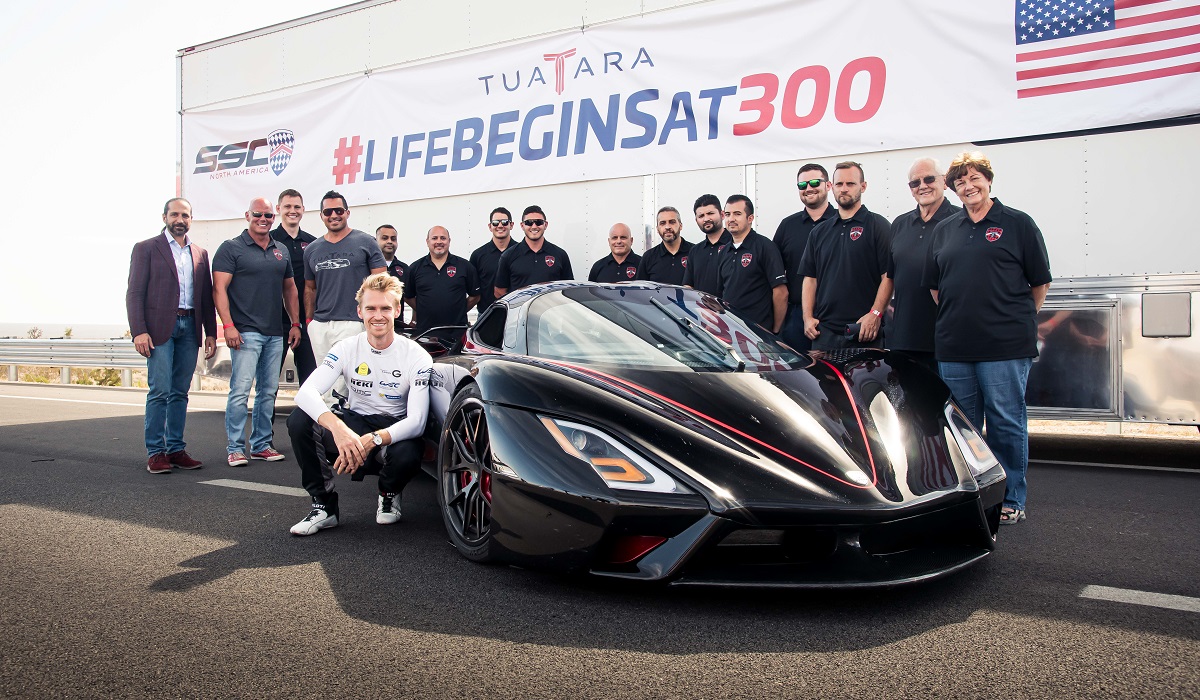From Wikipedia, the free encyclopedia
«Fastest car» redirects here. For the Netflix series, see Fastest Car.
This is a list of the world’s record-breaking top speeds achieved by street-legal production cars (as opposed to concept cars or modified cars). For the purposes of this list eligible cars are defined in the list’s rules. This list uses a different definition to the List of automotive superlatives. The variation is because the term production car is otherwise undefined.
List rules[edit]
Because of the inconsistencies with the various definitions of production cars, dubious claims by manufacturers and self-interest groups, and inconsistent or changing application of the definitions this list has a defined set of requirements. For further explanation of how these were arrived at see the talk pages of both this article and the above link. After the Koenigsegg Agera RS was found not eligible for this list since only 11 cars had engines rated higher than 865 kW, the former 25 car minimum was dropped and replaced with new rules based on suggestions by Koenigsegg PR manager Steven Wade.
Post 1945 and over 200 km/h (124 mph) only[edit]
This list is also limited to post World War II production road cars which reached more than 200 km/h (124 mph), older cars are excluded even if they were faster. The Benz Velo as the first petrol driven car is the only exception.
Production car definition[edit]
For the purposes of this list, a production car is defined as a vehicle that is:
- constructed principally for retail sale to consumers, for their personal use, to transport people on public roads (no commercial or industrial vehicles are eligible)
- available for commercial sale to the public in the same specification as the vehicle used to achieve the record
- manufactured in the record-claiming specification by a manufacturer whose WMI number is shown on the VIN, including vehicles that are modified by either professional tuners or others that result in a VIN with a WMI number in their name (for example, cars manufactured by RUF with Porsche parts and RUF’s WMI W09 are eligible; cars modified by them with Porsche’s WMI, WP0, aren’t)
- pre-1981 vehicles must be made by the original vehicle manufacturer and not modified by either professional tuners or individuals
- street-legal in its intended markets, having fulfilled the homologation tests or inspections required under either a) United States of America, b) European Union, or c) Japanese law to be granted this status
- sold in more than one national market.
Measurement of top speed[edit]
To establish the top speed for cars the requirement is, in addition to the above, an independent road test with a two-way run. The mean of the top speed for both runs is taken as the car’s top speed.[1][2] In instances where the top speed has been determined by removing the limiter, the test met these requirements, and the car is sold with the limiter on then the limited speed is accepted as meeting this requirement. For the McLaren F1 the estimation by Car and Driver about the speed at the rev-limiter is used.
Record-breaking production vehicles[edit]
| Year | Make and model | Top speed | Engine | Number built | Comment |
|---|---|---|---|---|---|
| 1894 | Benz Velo | 20 km/h (12 mph)[3] | 1,045 cm3 (63.8 cu in) single-cylinder 1.1 kW (1.5 PS; 1.5 bhp) | 1,200 | First production car |
| 1949 | Jaguar XK120 | 200.5 km/h (124.6 mph)[4] | 3,442 cm3 (210.0 cu in) inline-6 119 kW (162 PS; 160 hp) | 12,000 | Some publications cite the XK120’s timed top speed as almost 214 km/h (133 mph) in 1949.[5] The XK120 that achieved this speed was a tuned prototype, not a production car. The production car reached 200.5 km/h (124.6 mph). |
| 1955 | Mercedes-Benz 300SL | 242.5 km/h (150.7 mph)[6] | 2,996 cm3 (182.8 cu in) inline-6 158 kW (215 PS; 212 hp) | 1,400 | Two-way average speed tested by Automobil Revue in 1958. 245 km/h (152.2 mph) reached in one direction. |
| 1959 | Aston Martin DB4 GT | 245 km/h (152 mph)[7] | 3,670 cm3 (224 cu in) inline-6 225 kW (306 PS; 302 hp) | 75 | Tested by Autosport in December 1961. |
| 1963 | Iso Grifo GL 365 | 259 km/h (161 mph)[8] | 5,354 cm3 (326.7 cu in) V8 268 kW (365 PS; 360 hp) | over 400 | Tested by Autocar in 1966. A total of 412 Iso Grifos were built 1963–1974.[9] |
| 1965 | AC Cobra Mk III 427 | 266 km/h (165 mph)[10] | 6,998 cm3 (427.0 cu in) V8 362 kW (492 PS; 485 hp) | >25 | Tested by Car & Driver. Top speed described as observed |
| 1967 | Lamborghini Miura P400 | 275 km/h (171 mph)[11] | 3,929 cm3 (239.8 cu in) V12 261 kW (355 PS; 350 hp) | 275 | Tested by Motor in June 1967. Over 750 units built in 1966–1973 period, which includes P400, P400 S and P400 SV models. |
| 1968 | Ferrari 365 GTB/4 Daytona | 280 km/h (174 mph)[12] | 4,390 cm3 (268 cu in) V12 262 kW (357 PS; 352 hp) | about 1,400 | Tested by Autocar in 1971. |
| 1969 | Lamborghini Miura P400S | 288.6 km/h (179.3 mph)[13] | 3,929 cm3 (239.8 cu in) V12 276 kW (375 PS; 370 hp) | 338 | Tested by Sport Auto in 1970. |
| 1982 | Lamborghini Countach LP500 S | 293 km/h (182 mph)[14] | 4,754 cm3 (290.1 cu in) V12 280 kW (380 PS; 375 hp) | 323 | Tested by Auto, Motor und Sport |
| 1983 | Ruf BTR | 305 km/h (190 mph)[15] | 3,367 cm3 (205.5 cu in) turbocharged flat-6 275 kW (374 PS; 369 hp) | about 20–30 |
Tested by Auto, Motor und Sport, about 20-30 built with Ruf VIN |
| 1986 | Porsche 959 | 319 km/h (198 mph)[16] | 2,849 cm3 (173.9 cu in) twin-turbocharged flat-6 331 kW (450 PS; 444 hp) | 337 | Tested by Road & Track in 1987. The 959 Deluxe version attained 317 km/h (197 mph), the Sport version 319 km/h (198 mph). 29 were built in a performance-enhanced 379 kW (508 hp; 515 PS) sports version which reached 339 km/h (211 mph) tested by Auto, Motor und Sport at Nardo in 1988.[17][18] |
| 1987 | Ruf CTR | 342 km/h (213 mph)[17] | 3,367 cm3 (205.5 cu in) twin-turbocharged flat-6 345 kW (469 PS; 463 hp) | 29[19] | Tested by Auto, Motor und Sport at Nardò Ring in 1988. |
| 1993 | Dauer 962 Le Mans | 404.6 km/h (251.4 mph)[20] | 2,994 cm3 (182.7 cu in) twin-turbocharged flat-6 537 kW (730 PS; 720 hp) | 13 | Independently measured at Ehra-Lessien in November 1998.[21] |
| 2005 | Bugatti Veyron EB 16.4 | 408.47 km/h (253.81 mph) | 7,993 cm3 (487.8 cu in) quad-turbocharged W16 736 kW (1,001 PS; 987 hp) | 300 | Recorded and verified by German inspection officials on 19 April 2005.[22] |
| 2007 | SSC Ultimate Aero | 412.22 km/h
(256.14 mph) |
6.3-liter twin turbo V8 engine | 5 | Inspected and verified by Guinness World Records on 9 October 2007. |
| 2010 | Bugatti Veyron 16.4 Super Sport | 431.072 km/h (267.856 mph) | 7,993 cm3 (487.8 cu in) quad-turbocharged W16 882 kW (1,200 PS; 1,183 hp) | 30 | Out of the initial production run of 30 cars, 5 were named the Super Sport World Record Edition, which had the same electronic limiter as the other 25 – but turned off. Pierre-Henri Raphanel drove the unlimited Super Sport World Record Edition to a 431.072 km/h (267.856 mph) two-way average, verified by Guinness World Records.[23][24][25] When sold, the electronic limiters were re-activated, limiting them to the same 415 km/h (258 mph) as the entire production run. |
| 2017 | Koenigsegg Agera RS | 447.19 km/h (277.87 mph) | 5,000 cm3 (310 cu in) twin-turbocharged V8 1,000 kW (1,360 PS; 1,341 hp) | 25 | The base engine is rated at 865 kW (1,176 PS; 1,160 hp), 11 cars were factory specced with the 1 MW (1,360 PS; 1,341 hp) option. Niklas Lilja drove the 1 MW Agera RS to a top speed of 447.19 km/h (277.87 mph), independently verified by Racelogic.[26][27][28][29][30][31] |
Difficulties with claims[edit]
Comparing claimed speeds of the fastest production cars in the world, especially in historical cases, is difficult as there is no standardized method for determining the top speed and no central authority to verify any such claims. Examples of the difficulties faced were highlighted in a two-week long dispute regarding Bugatti’s record set in 2010, and Hennessey’s 2013 claim that their own top speed run – slower than Bugatti’s, lacking the required two-way average, and lacking the minimum 25 car production run – was the real record, due to an issue regarding electronic limiters.[32][33]
Bugatti Veyron limiter removal[edit]
On 4 July 2010, the Bugatti Veyron Super Sport reached 431.072 km/h (267.856 mph) for a two-way average. Bugatti built 30 identical Super Sports, with 5 of them named World Record Edition. All 30 were equipped with electronic limiters, but the World Record Edition had their limiters turned off for the record attempt. After the record run, all five had their electronic limiters reactivated, so that the entire production run was delivered to customers with a limit of 415 km/h (257.87 mph). Guinness Book of Records, which had listed speeds by British cars with modified rev. limiter as production car records in the 1990s, listed the unlimited 431.072 km/h (267.856 mph) as the production car speed record.
In April 2013, following a press release claiming the record for the Hennessey Venom GT due to the electronic limiter issue, The Sunday Times quoted Guinness‘ public relations director Jaime Strang as saying: «As the car’s speed limiter was deactivated, this modification was against the official guidelines. Consequently, the vehicle’s record set at 431.072 km/h (267.856 mph) is no longer valid.»[32] Five days later, Guinness World Records officially posted on its website that it: «…would like to confirm that Bugatti’s record has not been disqualified; the record category is currently under review.»[34] Five days later Bugatti’s speed record was confirmed: «Following a thorough review conducted with a number of external experts, Guinness World Records is pleased to announce the confirmation of Bugatti’s record of Fastest production car achieved by the Veyron 16.4 Super Sport. The focus of the review was with respect to what may constitute a modification to a car’s standard specification. Having evaluated all the necessary information, Guinness World Records is now satisfied that a change to the speed limiter does not alter the fundamental design of the car or its engine.»[32][33]
Cars excluded from the list[edit]
Some cars were not considered to be the fastest production vehicles, for various reasons. Here is a list of some well-known cars that have not been able to meet standards needed to be the fastest production car.
| Year | Make and model | Top speed | Engine | Number built | Comment |
|---|---|---|---|---|---|
| 1951 | Pegaso Z-102 | 245 km/h (152 mph) | 3,178 cm3 (193.9 cu in) V8 268 kW (365 PS; 360 bhp) | 84 | 360 hp turbocharged variant. Tested by Belgian Automobile club, at Belgium’s Jabbeke highway, but the results are not officially recognized worldwide. Classic Car commented that the Z-102 tested was a proto-type.[35] |
| 1959 | Maserati 5000 GT | 277 km/h (172.4 mph) | 4,935 cm3 (301.2 cu in) V8 254 kW (345 PS; 340 bhp) | 2 | No accurate measurement and only the first two cars had the 250 kW (340 PS; 340 hp) engine, 22 cars had coachwork by Allemano, 12 by 7 other companies[36] |
| 4,941 cm3 (301.5 cu in) V8 242 kW (330 PS; 325 bhp) | 32 | ||||
| 1985 | Lamborghini Countach 5000QV | 298 km/h (185 mph)[37] | 5,167 cm3 (315.3 cu in) V12 335 kW (455 PS; 449 hp) | 676 | Tested by Auto, Motor und Sport. The car which was tested 305.9 km/h (190.1 mph) by Fast Lane in 1986 and listed in the Guinness Book of World Records 1988 had a factory modified airbox.[38] |
| 1990 | Vector W8 | 389 km/h (242 mph) for prototype | 5,973 cm3 (364.5 cu in) twin-turbocharged V8 466 kW (634 PS; 625 hp) | 17 production models | No verified top speed for production model, 350 km/h (218 mph) claimed |
| 1992 | Jaguar XJ220 | 338.8 km/h (210.5 mph)[39] | 3,498 cm3 (213.5 cu in) twin-turbocharged V6 404 kW (550 PS; 542 hp) | 281 | Tested by Road & Track. The 349.4 km/h (217.1 mph) Guinness World Records speed was measured by Jaguar one-way without independent control with a car modified for about 50 extra horsepower, the 341.7 km/h (212.3 mph) claims were also factory measured without independent control.[40] |
| 2004 | Koenigsegg CCR | 387.866 km/h (241.009 mph) | 4,700 cm3 (290 cu in) twin-supercharged V8 601 kW (817 PS; 806 hp) | 14 | Recorded at the Nardò Ring testing facility on 28 February 2005. Excluded from the list due to being a single directional run.[41] |
| 2014 | Hennessey Venom GT | 435.31 km/h (270.49 mph)[1] | 7,000 cm3 (430 cu in) twin-turbocharged V8 928 kW (1,261 PS; 1,244 bhp) | 16 | Single direction top speed test run in 2014 and no Hennessey VIN. |
| 2019 | Bugatti Chiron Super Sport 300+ | 490.484 km/h (304.773 mph) | 8,000 cm3 (490 cu in) quad-turbocharged W16 1,177 kW (1,600 PS; 1,578 hp) | 100-110[i] | On 2 August 2019, Andy Wallace achieved a maximum of 490.484 km/h (304.773 mph) in a pre-production prototype at Ehra-Lessien, which was verified by TÜV. The production version has the same bodywork, engine and gearbox but no roll cage, different seats, ride height and an electronically limited top speed of 440 km/h (273.4 mph). Excluded from the list because it was a uni-directional top speed run.[44][45][46][47][48] |
| 2022 | SSC Tuatara | 475 km/h (295 mph) | 5,900 cm3 (360 cu in) twin-turbocharged V8 1,300 kW (1,770 PS; 1,750 hp) | 100 (production to commence) | On May 14, 2022, Larry Caplin’s Tuatara reached a one-way speed of 295 mph (475 km/h) over the course of 2.3 miles (3.7 km) at Space Florida’s Launch and Landing Facility. This was verified by two Racelogic VBOX GNSS and a Life Racing GPS speed measurement systems, as well as a Racelogic technician on hand.[49][50] Excluded from the list because it was a uni-directional top speed run. The car has not been homologated for road use and is therefore at present not street legal. |
See also[edit]
- History of the automobile
- Land speed record
- List of fastest production cars by acceleration
- List of production cars by power output
- List of production cars by specific power
References[edit]
- ^ a b Nunez, Alex (24 February 2014), «The Hennessey Venom GT is the world’s fastest car; Hits 270 mph on tarmac reserved for astronauts», Road & Track, archived from the original on 17 March 2018, retrieved 16 March 2018
- ^ «FIA World Land Speed Records». Federation Internationale de l’Automobile. 10 June 2012. Archived from the original on 1 November 2017.
- ^ Danielson, C. (12 September 2008). «eMercedesBenz Feature: The World’s First Production Car, The Benz Patent Motor Car Velocipede Of 1894». eMercedesBenz. Archived from the original on 24 March 2015.
- ^ Stoy, Andy (15 October 2012). «Worth the Wait». Autoweek. 62 (21): 40–41. ISSN 0192-9674.
But the XK120 was a post-war performance revelation, proving itself as the fastest production car in the world at the time.
- ^ Hodges, David; Burgess-Wise, David; Davenport, John; Harding, Anthony (1994). The Guinness Book of Car Facts and Feats (4 ed.). London: Guinness Publishing. p. 52. ISBN 0-85112-768-1.
- ^ «Mercedes-Benz 300 SL — der gezähmte Rennwagen für die Schickeria der Sechzigerjahre» [Mercedes-Benz 300 SL — the tamed racing car for the chic people of the 1960s]. Zwischengas (in German). Germany. 19 April 2011. Retrieved 30 September 2019.
- ^ «John Bolster Tests the Aston Martin DB4 G.T.». Autosport. December: 778. 1961.
- ^ «Autocar Road Test Number 2077». Autocar. 29 April. 1966.
- ^ Oleski, Frank; Lehbrink, Hartmut. 100 Jahre Sportwagen.
- ^ «Road Test Cobra 427» (PDF). Car and Driver. US. November 1965. Archived from the original (PDF) on 29 November 2014.
- ^ «Sackey, Joe. The Lamborghini Miura Bible» (PDF).
- ^ «Ferrari 365 GTB/4 Daytona review – on the road». Archived from the original on 6 May 2007. Retrieved 13 March 2016.
{{cite web}}: CS1 maint: bot: original URL status unknown (link) - ^ Sport Auto, numéro 100, mai 1970
- ^ Auto, Motor und Sport 15/1983
- ^ Auto, Motor und Sport 3/1987
- ^ Road & Track July 1987 Egan, Peter (29 May 2016). «In 1987, The World’s Fastest Cars Couldn’t Catch A 211-mph Twin-Turbo Ruf». Road & Track. US.
- ^ a b Auto, Motor und Sport 25/1988
- ^ Bernd Woytal (18 October 2015). «Ferrari F40 gegen Porsche 959: Nonplusultra-Supersportler der 80er – Auto Motor und Sport». auto motor und sport.
- ^ Bovington, Jethro (November 2012). «1987 Ruf CTR «Yellowbird» 911 Turbo Driven». Car and Driver. US. Retrieved 7 July 2018.
- ^ Evo September 2003: p.106-109
- ^ «Le Mans ist überall». autobild.de. Retrieved 11 April 2018.
- ^ «Bugatti Veyron». Archived from the original on 2 September 2011. Retrieved 28 April 2018.
- ^ «Fastest Production Car». Guinness World Records. Retrieved 7 March 2012.
- ^ «Veyron Super Sport hits 267 mph». Top Gear. Retrieved 6 July 2010.
- ^ «Guinness World Records statement: Fastest Production Car». Guinness World Records. 12 April 2013. Retrieved 13 May 2013.
- ^ Tsui, Chris. «The Koenigsegg Agera RS Is Now the Fastest Production Car Ever Made». The Drive. Retrieved 14 January 2018.
- ^ «The Koenigsegg Agera RS has claimed five speed records». Top Gear. 7 November 2017. Retrieved 14 January 2018.
- ^ «The World’s Fastest Car Is Made in Sweden». Retrieved 14 January 2018.
- ^ «The Koenigsegg Agera RS Is Officially the World’s Fastest Car». 4 November 2017. Retrieved 14 January 2018.
- ^ Drewitz, Ina. «Koenigsegg Agera RS Production Speed Record – VBOX Verified!». VBOX Motorsport. Retrieved 14 January 2018.
- ^ Wade, Steven (7 November 2017). «Koenigsegg Agera RS Achieves Multiple Production Car World Speed Records». Koenigsegg. Archived from the original on 8 November 2017. Retrieved 30 September 2019.
- ^ a b c Weiss, C.C. (16 April 2013). «And the world’s fastest car is … the Bugatti Veyron Super Sport (again)». New Atlas. GIZMAG. Retrieved 16 March 2018.
- ^ a b Kennedy, George (4 September 2015). «Fastest production car world not exactly clear cut». Yahoo! Autos. Retrieved 15 September 2017.
- ^ «Guinness World Records statement: Production car world records». Guinness World Records. 8 April 2013. Retrieved 14 January 2018.
- ^ Walsh, Mick (28 October 2020). «Pegaso Z102: born to fly». Classic & Sports Car. UK. Retrieved 1 May 2022.
- ^ «The Maserati 5000GT». maserati-alfieri.co.uk. Retrieved 14 January 2018.
- ^ Auto, Motor und Sport 12/1987 p.11
- ^ Prince, Max. «5 Things You Didn’t Know About the Lamborghini Countach». Retrieved 14 January 2018.
- ^ Road & Track January 1995 p.63-71
- ^ Green, Gavin (August 1992). «217mph!» (PDF). Car. London. Retrieved 16 March 2018.
- ^ Hanlon, Mike (2 March 2005). «Koenigsegg CCR Breaks World Speed Record for Production Cars». New Atlas. GIZMAG. Retrieved 16 March 2018.
- ^ Götze, Jan (3 April 2022). «Der 1600 PS starke Bugatti Chiron Super Sport macht sprachlos». AutoBild. Retrieved 15 May 2022. AutoBild Sportscars 5/2022 p.19
- ^ Rix, Jack (29 December 2021). «Sports day in a Bugatti Chiron Super Sport». Retrieved 15 May 2022.
- ^ «Bugatti Chiron Super Sport 300+». Bugatti. Retrieved 10 October 2020.
- ^ Bugatti hits 304.77mph in a Chiron. Top Gear. 2 September 2019. Archived from the original on 14 December 2021. Retrieved 9 September 2019 – via YouTube.
- ^ «Top gear reporting Bugatti Chiron breaking the 300mph barrier».
- ^ Sluys, Andrew (3 September 2019). «Watch: Bugatti Chiron hits 490km/h in a record-breaking speed run». Driven. New Zealand. Retrieved 3 September 2019.
- ^ «The Bugatti Chiron Super Sport+ is a production 300mph car». Top Gear. 8 September 2019. Retrieved 15 May 2022.
- ^ Blain, Loz (25 May 2022). «SSC Tuatara owner clocks 295 mph (475 km/h) in just 2.3 miles». New Atlas. US. Retrieved 26 May 2022.
- ^ Petroelje, Nathan (25 May 2022). «SSC does its homework; Tuatara hits 295 mph». Hagerty Media. US. Retrieved 26 May 2022.
- ^ 30 Super Sport 300+ in black-with-orange-stripes livery and about 70-80 mechanically identical ‘standard’ Super Sport[42][43]
И это не электромобиль!
Гиперкар SSC Tuatara 10 октября установил мировой рекорд скорости среди серийных автомобилей. Опытный пилот Оливер Уэбб смог разогнать автомобиль до 532 км/ч. Однако в рекорде будет указана средняя скорость — 508,73 км/ч.
Рекорд был установлен на 11-километровом прямом отрезке автострады State Route 160 в Неваде. Выглядело это так:
При этом, по заявлению Уэбба, автомобиль мог ехать быстрее:
Когда я приблизился к 331 миле в час (около 533 км/ч), Tuatara набрал почти 20 миль в час (где-то 31 км/ч) за предыдущие пять секунд. Он всё ещё шёл хорошо. Машина ещё не выдохлась. Боковой ветер помешал нам понять пределы возможностей автомобиля.
Оливер Уэбб
Автогонщик
Для достижения рекорда «самого быстрого серийного автомобиля» необходимо было выполнить несколько условий:
- Автомобиль должен быть идентичен серийному образцу, который сможет приобрести покупатель;
- Необходимо двигаться по одному и тому же маршруту в обе стороны. Оба показателя объединяются и между ними выбирается средняя скорость, чтобы избежать влияния ветра и наклона дороги на конечный показатель скорости. Так, Уэбб смог разогнать SSC Tuatara сначала до 301,07 миль/ч (484,53 км/ч), а на обратном пути — 331,15 миль/ч (532,93 км/ч). В рекорде записана средняя скорость: 508,73 км/ч;
- Скорость необходимо отслеживать с помощью сертифицированного оборудования, а также в присутствии двух мировых рекордсменов;
- Шины и топливо должны быть повседневными.
По ходу дела, помимо основного рекорда, были побиты ещё три:
- «Самая быстрая миля с хода на дороге общего пользования» — 313,12 миль/ч (503,92 км/ч);
- «Самый быстрый километр с хода на дороге общего пользования» — 321,35 миль/ч (517,16 км/ч);
- «Самая высокая скорость на дороге общего пользования» — 331,15 миль/ч (532,93 км/ч).
Конечно, назвать Tuatara серийным автомобилем довольно сложно: можно ли считать таковой машину, тираж которой не превысит сотни штук?
SSC Tuatara — один из немногих автомобилей, у которого по паспорту заявлено аж две мощности: 1369 лошадиных силы для обычного бензина и 1774 л. с. на смеси E85 (состоит на 85 % из этанола и на 15 % из бензина). Таковы показатели у 5,9-литрового V8, который получил два турбокомпрессора и систему впрыска с двумя форсунками на каждый из цилиндров. Этому двигателю помогает семиступенчатый «робот» CIMA.
Предыдущий рекорд был установлен в 2017 году на Koenigsegg Agera RS. Тогда на автомобиле удалось развить среднюю скорость в 447 км/ч:
Быстрее Koenigsegg был и Bugatti Chiron Super Sport 300+, пилотируемый гонщиком Энди Уоллесом. В сентябре 2019 года он смог разогнать гиперкар до 490 км/ч. Однако это не был серийный автомобиль, но списком изменений Bugatti так и не поделилась.
Сегодня читают
В сегменте сверхмощных и ультрадорогих серийный автомобилей продолжается битва за звание самого быстрого. Гиперкар Tuatara компании SSC North America свой рекорд скорости (508,7 км/ч) установил в октябре прошлого года , но конкуренты и критики назвали его фейком. Чтобы доказать свою правоту, SSC North America решила повторить заезды под присмотром независимого арбитра, получилось только 455,3 км/ч, но и этого оказалось достаточно, чтобы назвать Tuatara самым быстрым серийным автомобилем в мире.
SSC Tuatara — это представленный в феврале 2020 года американский гиперкар, оснащённый 5,9-литровым битурбомотором V8 мощностью 1774 л.с. (за подробностями отправляем к нашему отдельному материалу). Такой мощности вполне достаточно, чтобы стать самым быстрым серийным автомобилем на Земле.
С 2017 года это почётное звание принадлежит шведскому гиперкару Koenigsegg Agera RS — 446,9 км/ч. В 2019-м Bugatti сообщила, что её Chiron Super Sport 300+ разогнался до 490,4 км/ч. Осенью 2020-го SSC North America рапортовала о достижении её гиперкаром Tuatara скорости 508,7 км/ч и приложила видеозапись заездов, которые проходили в штате Невада на 7-километровом прямолинейном участке региональной автострады №160.
Скептики посмотрели эту видеозапись и сказали, что запечатлённый на ней автомобиль никак не может ехать с заявленной скоростью — мол, картинка с цифрами не стыкуется. Уточним, что 508,7 км/ч — это, по общепринятым правилам установления рекордов, средняя скорость из двух попыток, совершённых в разных направлениях трассы в течение одного часа. Абсолютный же максимум Tuatara в одной из двух попыток составил 532,93 км/ч — по крайней мере, так говорили в SSC North America. Но им, повторимся, не поверили.
Представители Koenigsegg тоже не постеснялись заявить, что не верят рекорду SSC Tuatara и считают свою машину, то есть Agera RS, самой быстрой в мире. А как же Bugatti? Его рекорд, хоть и был сертифицирован немецким TÜV, скептикам тоже пришлось забраковать, так как измерения проходили только в одном направлении трассы и средняя скорость, как того требует дотошная публика, не вычислялась.
В Bugatti на критику никак не отреагировали и вряд ли уже отреагируют (будущее этой марки находится под вопросом), а вот SSC North America упёрлась и решила доказать, что Tuatara всё-таки быстрее всех. При этом она призналась, что видеозапись «рекорда» была смонтированной.
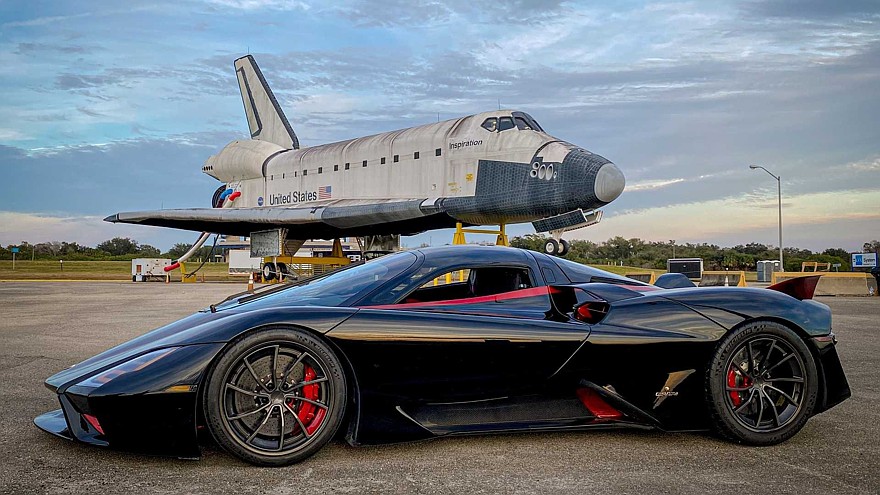
Первая попытка повторить рекорд была предпринята в декабре во Флориде на площадке аэрокосмического центра, куда раньше приземлялись Шаттлы. Эта попытка оказалась неудачной из-за проблем с двигателем. А вот январские заезды, как считают в SSC North America, увенчались успехом. На сей раз Tuatara была увешана сразу пятью спутниковыми измерителями скорости, в том числе Racelogic Vbox, а главное — на заездах присутствовал технический директор американского представительства Racelogic, который может гарантировать, что охотники за рекордами ничего в приборах не подкручивали.
Итог, зафиксированный в сертификате Racelogic USA, такой: средняя скорость из двух попыток — 455,3 км/ч, абсолютный максимум — 460,4 км/ч. То есть Koenigsegg Agera RS остался позади.
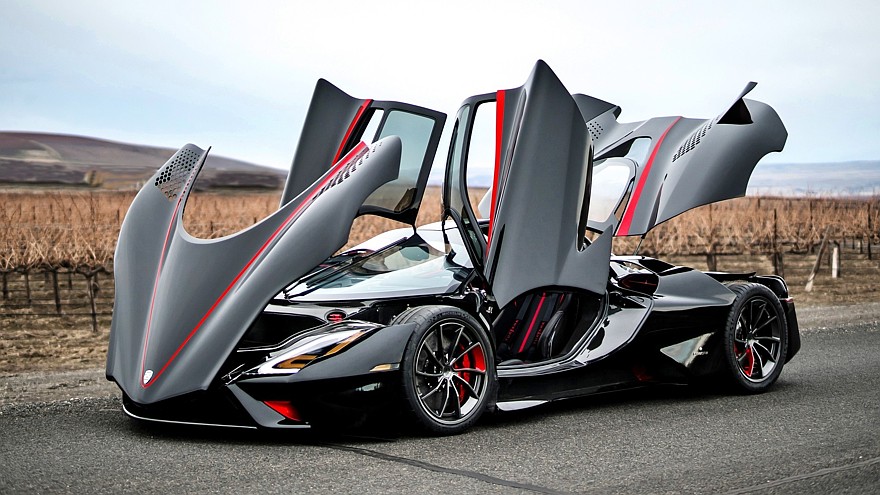
Что до осенних астрономических 500 с лишним км/ч, то SSC North America пообещала подтвердить их в будущем, поколдовав с настройками машины. Выходит, первая попытка всё же была фейком? Этого американская компания, конечно, не говорит и вред ли признается, даже если дело и правда было нечистым.
Между тем на рекорд скорости в классе серийных автомобилей претендуют также Koenigsegg со своей новой моделью Jesko и Hennessey со своим недавно представленным суперкаром Venom F5.
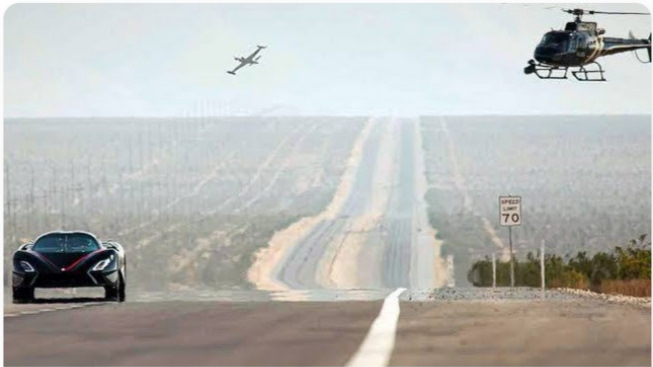
Гиперкар SSC Tuatara сверг с пьедестала Bugatti Chiron Super Sport, превысив сразу нескольких рекордных достижений.
Напомним, что официальный мировой рекорд скорости среди серийных автомобилей до этого принадлежал гиперкару Koenigsegg Agera RS (444,6 км/ч), неофициальный — Bugatti Chiron Super Sport (490,48 км/ч).
Рекордную попытку предприняли в штате Невада на перекрытом 11-километровом отрезке трассы State Route 160. SSC Tuatara под управлением британского гонщика Оливера Уэбба смог разогнаться по прямой до 484 км/ч и до 532,93 км/ч в обратном направлении.
В итоговом протоколе согласно требованиям Книги рекордов Гиннесса зафиксирована средняя скорость автомобиля, которая составила 508,73 км в час. Попутно были побиты еще три рекорда: «Самая высокая скорость на дороге общего пользования» (532,93 км/ч), «Самая быстрая миля на дороге общего пользования» (503,92 км/ч) и «Самый быстрый километр на дороге общего пользования» (517,16 км/ч).
Гиперкар SSC Tautara весом 1250 кг разработан фирмой Shelby Super Cars и оснащен 5,9-литровым мотором V8 с двумя турбинами, развивающим на биоэтаноле 1750 л.с., а на 92-м бензине — 1350 лошадиных сил. Ускорение до сотни занимает всего 2,5 секунды.
Источник: Журнал «ЗР»
На разгон до 533 км/ч понадобилось чуть более минуты
На днях был установлен новый мировой рекорд скорости на серийном автомобиле. Гиперкар SSC Tuatara на дороге общего пользования удалось разогнать до невероятных 532,93 км/ч, что сразу почти на 100 км/ч превосходит предыдущее официальное достижение, принадлежащее Koenigsegg Agera RS (444,6 км/ч).
И теперь мы можем посмотреть, как это было.
Как можно видеть, рекордов в разгоне никто не устанавливал — пилот наращивал скорость достаточно плавно. Несмотря на это, темп, которым машина набирала скорость после отметки в 300 и даже 400 км/ч, безусловно, впечатляет. Для достижения максимальной скорости понадобилось всего около 72 секунд, и это при том, что никто не пытался сделать это как можно быстрее.
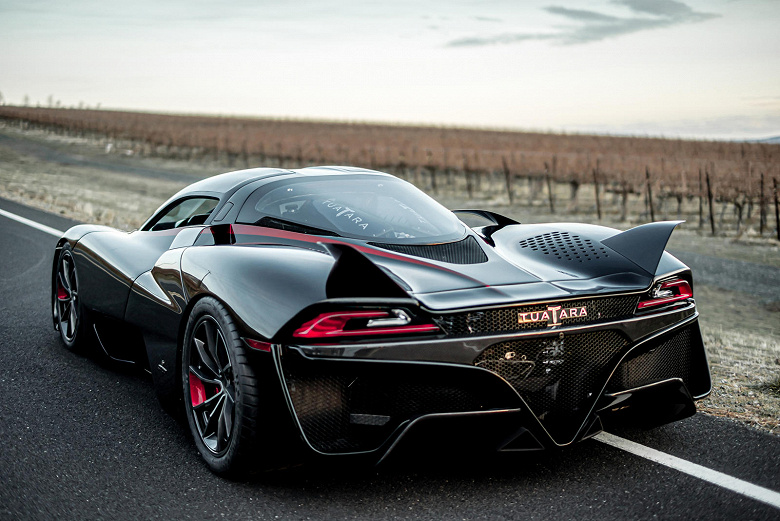
SSC Tuatara оснащён двигателем V8 объёмом 5,9 литра с двумя турбинами, развивающим 1350 либо 1750 л.с. в зависимости от типа топлива.
Фото:
фирма-производитель
После прошлогоднего заезда тест-пилота Энди Уоллеса на гиперкаре Bugatti Chiron, который ему удалось разогнать до 490,484 км/ч, в кругах автомобильных энтузиастов начались споры, связанные со статусом нового рекорда. Дело в том, что рекордное купе в компании аккуратно нарекли «почти серийным прототипом» из-за доработанного при помощи специалистов из компании Dallara шасси, увеличенной на 100 л.с. (до 1600 л.с.) отдачи двигателя W16 и удлиненного на 25 см кузова с растянутой кормой. Условия фиксации рекорда тоже вызывали вопросы: правилами предписаны два заезда в обоих направлениях, но в обратную сторону Chiron так и не поехал. Поэтому формально самым быстрым серийным автомобилем оставался шведский гиперкар Koenigsegg Agera RS, набравший 446,97 км/ч. До сегодняшнего дня.
Новым рекордсменом стал американский гиперкар SSC Tuatara, превысивший заветную отметку в 500 км/ч. Его максимальную скорость высчитывали по итогам двух заездов: 484,53 км/ч в одну сторону и невероятные 532,93 км/ч — в другую. Среднее арифметическое составило 508,73 км/ч. По правилам, именно этот результат и будет зафиксирован в качестве рекорда.
В заездах участвовал серийный автомобиль, хотя первый прототип машины был представлен еще в далеком 2011 году. Долгое время о проекте ничего не было слышно, затем три года спустя на конкурс элегантности в Пеббл-Бич компания SSC привезла немного доработанную версию. А серийную модификацию и вовсе показали лишь летом 2018-го. Поставки первых товарных машин начались год назад. По плану, тираж модели составит 100 экземпляров.
Напомним, среднемоторное заднеприводное купе оснащено двигателем V8 5.9 с битурбонаддувом и «плоским» коленвалом. Он разработан самой фирмой SSC North America (в прошлом известной как Shelby SuperCars) в содружестве с ателье Nelson Racing Engines. Мотор работает в паре с семиступенчатой роботизированной трансмиссией. Мощность агрегата — 1369 л.с. при работе на обычном бензине и 1774 л.с. на гоночном топливе Е85.
Машина почти полностью изготовлена из углепластика, весит всего 1247 кг и имеет очень низкий коэффициент аэродинамического сопротивления (0,279). Первоначально при разработке гиперкара инженеры утверждали, что рассчитывают разогнать автомобиль до 300 миль в час (482,80 км/ч), однако в итоге результат даже превзошел их ожидания.
По словам пилота Оливера Уэбба, который находился за рулем рекордного гиперкара, даже на скорости 532 км/ч автомобиль продолжал уверенно ускоряться: последние 32 км/ч Tuatara набрала менее чем за пять секунд. То есть итоговый результат мог быть еще лучше, однако из-за бокового ветра (испытания проводились на 11-километровом участке шоссе SR 160 в американском штате Невада) приблизиться к предельным возможностям машины так и не удалось.
Кроме того, по результатам заезда были побиты еще три рекорда, установленные гиперкаром Koenigsegg Agera RS три года назад. Tuatara показала самую высокую среднюю скорость на дороге общего пользования. Более того, на протяжении километра купе смогло двигаться со средней скоростью 517,16 км/ч, а одну милю (1,61 км) оно проехало с результатом 503,92 км/ч.
В прошлом году глава компании Bugatti Штефан Винкельманн объявил о том, что фирма выходит из «скоростной» гонки вооружений, поэтому в обозримом будущем у SSC North America будет лишь два потенциальных конкурента. Помимо компании Koenigsegg, которая готовится к проведению заездов нового гиперкара Jesko Absolut (к слову, после этого шведы тоже собираются завязать с рекордами), есть еще техасская фирма Hennessey со своей первой самостоятельной моделью Venom F5. Впрочем, теперь и тем и другим придется поднимать планку, ведь прежний ориентир, установленный доработанным гиперкаром Bugatti Chiron, остался в прошлом.

